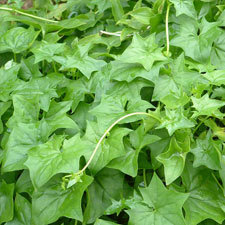 German ivy
German ivy
Common name: German ivy
Botanical name: Delairea odorata
Management category: Advisory
Originates from South Africa and was brought to New Zealand as an ornamental plant. Thought to have naturalised in the 1870’s.
Why is it a pest?
- Fast growing with a dense, smothering habit.
- Smothers small trees and lower vegetation, preventing native seedlings from establishing.
- Is considered to be toxic to livestock and humans.
- As it will tolerate a range of habitats and soil types, it have the ability to impact negatively on a variety of native flora species.
Where is it found?
- Generally found in open coastal habitats around waste places and scrubland.
- Many wind-blown seeds are distributed long distances. German ivy is also spread through dumped vegetation and soil movement.
- It can be found throughout the Bay of Plenty.
What does it look like?
- Scrambling vine from the same family as ragwort with thin, weak stems.
- Thin, soft, glossy, hairless leaves are ivy-shaped and clammy to touch.
- Flowers are yellow and look similar to daisies. They appear from May through to October.
- Seeds are feathery and wind dispersed.
What are the rules?
Advisory
The Bay of Plenty Regional Council does not enforce the control of advisory species. It is landowner/occupier responsibility to manage these pests. Council may provide advice on how to manage or control these species if required.
How do you get rid of it?
Recommended:
- Hand pull small plants, or dig out roots year around.
- Stump treatment larger plants year around with glyphosate or metsulfuron.
- Cut stems below waste height and spray (spring to summer) remaining vegetation with glyphosate, metsulfuron-methyl, picloram or dicamba with penetrant.
CAUTION: When using any herbicide or pesticide, PLEASE READ THE LABEL THOROUGHLY to ensure that all instructions and directions for the purchase, use and storage of the product, are followed and adhered to.
Read more on pest control advice, information and regulations.
Images





